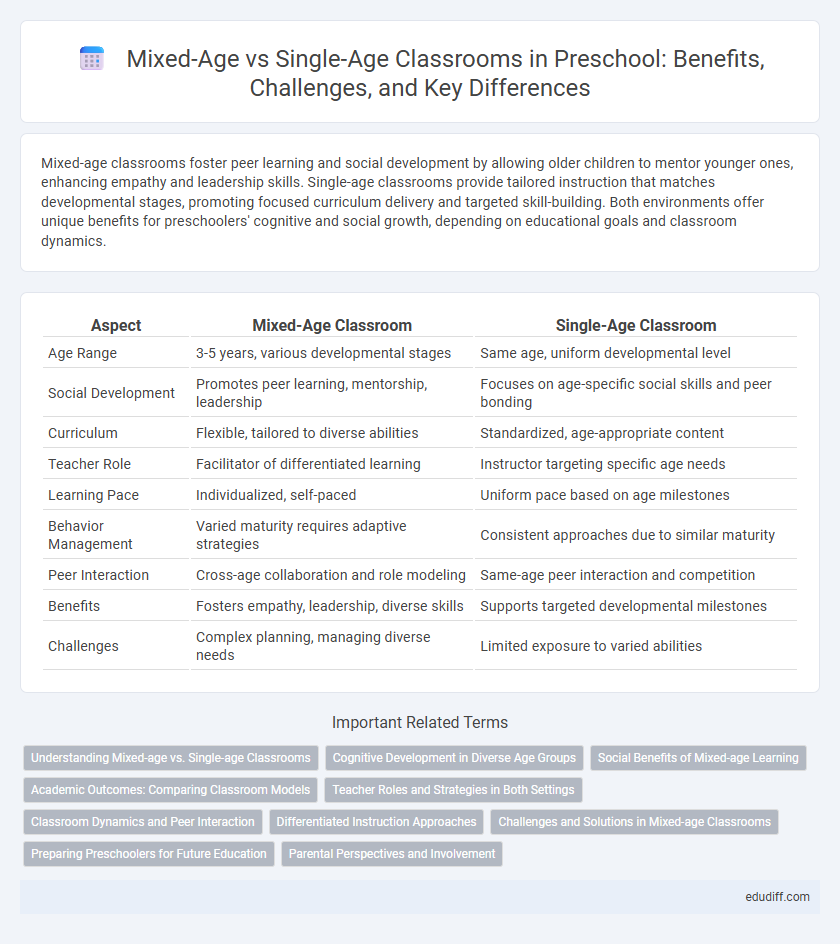Mixed-age classrooms foster peer learning and social development by allowing older children to mentor younger ones, enhancing empathy and leadership skills. Single-age classrooms provide tailored instruction that matches developmental stages, promoting focused curriculum delivery and targeted skill-building. Both environments offer unique benefits for preschoolers' cognitive and social growth, depending on educational goals and classroom dynamics.
Table of Comparison
| Aspect | Mixed-Age Classroom | Single-Age Classroom |
|---|---|---|
| Age Range | 3-5 years, various developmental stages | Same age, uniform developmental level |
| Social Development | Promotes peer learning, mentorship, leadership | Focuses on age-specific social skills and peer bonding |
| Curriculum | Flexible, tailored to diverse abilities | Standardized, age-appropriate content |
| Teacher Role | Facilitator of differentiated learning | Instructor targeting specific age needs |
| Learning Pace | Individualized, self-paced | Uniform pace based on age milestones |
| Behavior Management | Varied maturity requires adaptive strategies | Consistent approaches due to similar maturity |
| Peer Interaction | Cross-age collaboration and role modeling | Same-age peer interaction and competition |
| Benefits | Fosters empathy, leadership, diverse skills | Supports targeted developmental milestones |
| Challenges | Complex planning, managing diverse needs | Limited exposure to varied abilities |
Understanding Mixed-age vs. Single-age Classrooms
Mixed-age classrooms in preschools group children from different age ranges, fostering social development and peer learning, while single-age classrooms focus on a specific developmental stage, allowing targeted curriculum and skill-building suited to uniform age groups. Research highlights that mixed-age settings promote leadership, adaptability, and empathy as younger children learn from older peers, whereas single-age settings benefit from tailored instruction and assessment aligned with benchmark milestones. Educators often balance the advantages of both by incorporating differentiated teaching strategies to address diverse learning needs in preschool environments.
Cognitive Development in Diverse Age Groups
Mixed-age classrooms promote cognitive development by encouraging peer learning, where older children reinforce their knowledge by teaching younger peers, while younger children benefit from advanced models. Single-age classrooms tailor cognitive activities to specific developmental stages, maximizing targeted skill acquisition but may limit exposure to diverse problem-solving approaches. Research shows mixed-age settings enhance social cognition and adaptive thinking by exposing children to varied perspectives and challenges.
Social Benefits of Mixed-age Learning
Mixed-age classrooms enhance social development by encouraging cooperation, empathy, and leadership as older children mentor younger peers. These environments promote diverse interactions and natural role modeling, fostering adaptability and communication skills. Such social benefits contribute to a supportive community where children build lasting relationships across age differences.
Academic Outcomes: Comparing Classroom Models
Mixed-age classrooms promote peer learning and social development, leading to improved language and cognitive skills compared to single-age environments. Research from the National Institute for Early Education Research indicates children in mixed-age settings often demonstrate higher adaptability and problem-solving abilities. Single-age classrooms offer targeted instruction aligned with specific developmental stages but may limit opportunities for collaborative learning across age groups.
Teacher Roles and Strategies in Both Settings
In mixed-age classrooms, teachers leverage differentiated instruction and individualized learning plans to address diverse developmental stages, promoting peer mentoring and social-emotional growth. Single-age classrooms allow educators to implement targeted, age-specific curricula and behavior management strategies, fostering a focused learning environment tailored to homogeneous developmental needs. Both settings require adaptive assessment methods and flexible classroom management to optimize engagement and academic progress.
Classroom Dynamics and Peer Interaction
Mixed-age classrooms promote diverse classroom dynamics by encouraging mentorship and collaboration among children at different developmental stages, enhancing social skills and empathy. Single-age classrooms provide more uniform peer interaction, allowing for targeted, age-specific activities that support cognitive development within the same maturity level. Research shows mixed-age settings foster adaptability and leadership, while single-age settings optimize curriculum pacing and peer modeling.
Differentiated Instruction Approaches
Mixed-age classrooms enable differentiated instruction by allowing educators to tailor lessons to a broader developmental range, fostering peer learning and individualized growth. Single-age classrooms offer targeted instructional strategies aligned with specific age-related milestones, facilitating focused skill development. Both environments support differentiated instruction, but mixed-age settings uniquely promote social-emotional learning through diverse interactions and mentorship opportunities.
Challenges and Solutions in Mixed-age Classrooms
Mixed-age classrooms present challenges such as varied developmental stages causing difficulty in curriculum planning and classroom management. Teachers can implement differentiated instruction and peer mentoring to address diverse learning needs and social dynamics. Structuring activities that promote collaboration across age groups fosters inclusivity and enhances cognitive and social development.
Preparing Preschoolers for Future Education
Mixed-age classrooms foster social development and adaptability by encouraging peer learning, which enhances cognitive and emotional skills essential for future educational success. Single-age classrooms focus on age-specific developmental milestones, providing targeted instruction that aligns closely with standardized early education curricula. Preparing preschoolers in mixed-age environments often results in improved problem-solving abilities and collaboration skills, while single-age settings offer structured progression tailored to individual readiness.
Parental Perspectives and Involvement
Parents in mixed-age classrooms often appreciate the diverse social interactions and developmental modeling opportunities, fostering a collaborative learning environment that mirrors real-world relationships. Single-age classrooms provide parents with targeted curriculum goals and milestones tailored to a specific developmental stage, offering clearer progress tracking and focused peer interactions. Parental involvement tends to increase in mixed-age settings due to the variety of activities and roles children engage in, encouraging family participation in creating a dynamic community.
Mixed-age classroom vs Single-age classroom Infographic

 edudiff.com
edudiff.com